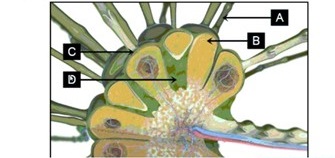What is the function of the middle layer of the uterine wall?
To ensure that the uterus is securely connected to the supporting ligaments
To allow the uterus to shed tissue during menstruation
To allow the uterus to contract during childbirth to expel the fetus
To provide the uterus with adequate space to grow a fetus
The Correct Answer is C
A. To ensure that the uterus is securely connected to the supporting ligaments: This is not the primary function of the middle layer (myometrium); rather, the supporting ligaments provide stability to the uterus.
B. To allow the uterus to shed tissue during menstruation: This is primarily the function of the endometrium, the inner layer of the uterine wall.
C. To allow the uterus to contract during childbirth to expel the fetus: The middle layer, known as the myometrium, is composed of smooth muscle that contracts during labor to help expel the fetus.
D. To provide the uterus with adequate space to grow a fetus: While the uterine structure allows for fetal growth, the myometrium’s primary role is in contractions rather than providing space.
Nursing Test Bank
Naxlex Comprehensive Predictor Exams
Related Questions
Correct Answer is D
Explanation

Trabeculae: These are thin connective tissue strands that extend from the capsule of the lymph node into the interior. They help to divide the lymph node into distinct compartments or regions, which include the cortex (outer area) and medulla (inner area). This compartmentalization is important for the organization and function of the lymph node, allowing it to efficiently filter lymph and facilitate the immune response.
Correct Answer is B
Explanation
A. It protects the lungs from overinflating: While protective reflexes (like the Hering-Breuer reflex) exist to prevent overinflation, this is primarily a function of the lungs and the medulla, not directly the hypothalamus.
B. It modifies the medulla oblongata's functions: The hypothalamus influences the medulla oblongata, which controls the basic rhythm and rate of breathing, allowing the body to adjust ventilation in response to emotional states, temperature changes, and other stimuli.
C. It maintains the basic rhythm of breathing: The basic rhythm of breathing is primarily generated by the medulla oblongata and pons, while the hypothalamus modulates these functions rather than maintaining them directly.
D. It monitors the respiration rate in sleep and awake states: While the hypothalamus does play a role in the sleep-wake cycle, the actual monitoring of respiration rate is managed by the respiratory centers in the brainstem (medulla and pons).
Whether you are a student looking to ace your exams or a practicing nurse seeking to enhance your expertise , our nursing education contents will empower you with the confidence and competence to make a difference in the lives of patients and become a respected leader in the healthcare field.
Visit Naxlex, invest in your future and unlock endless possibilities with our unparalleled nursing education contents today
Report Wrong Answer on the Current Question
Do you disagree with the answer? If yes, what is your expected answer? Explain.
Kindly be descriptive with the issue you are facing.
